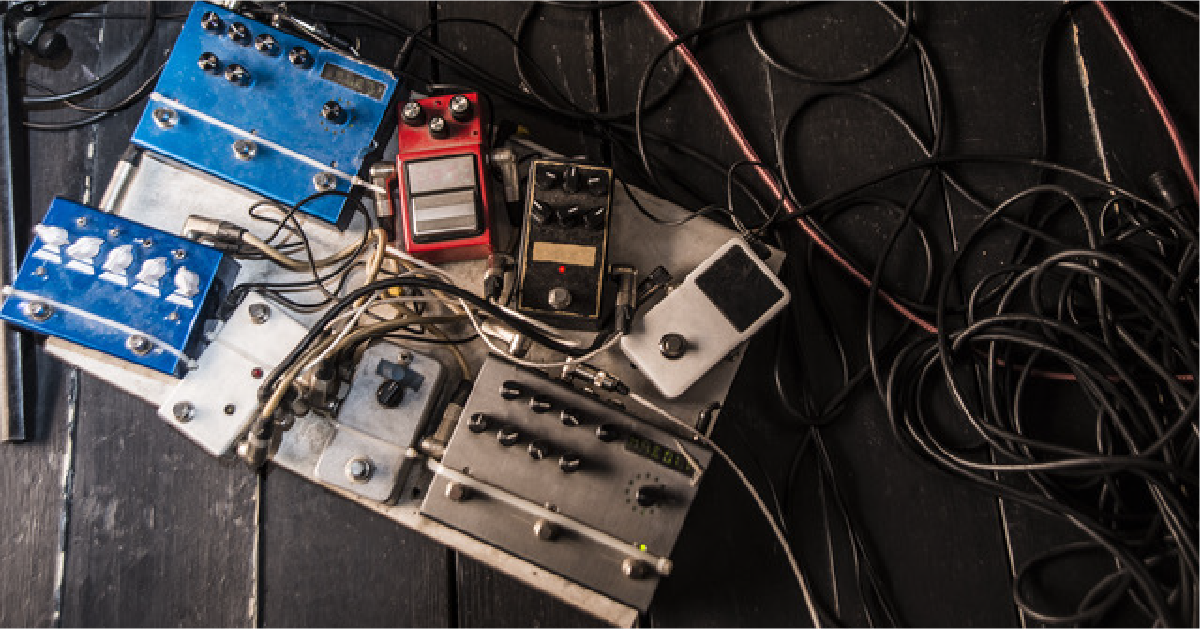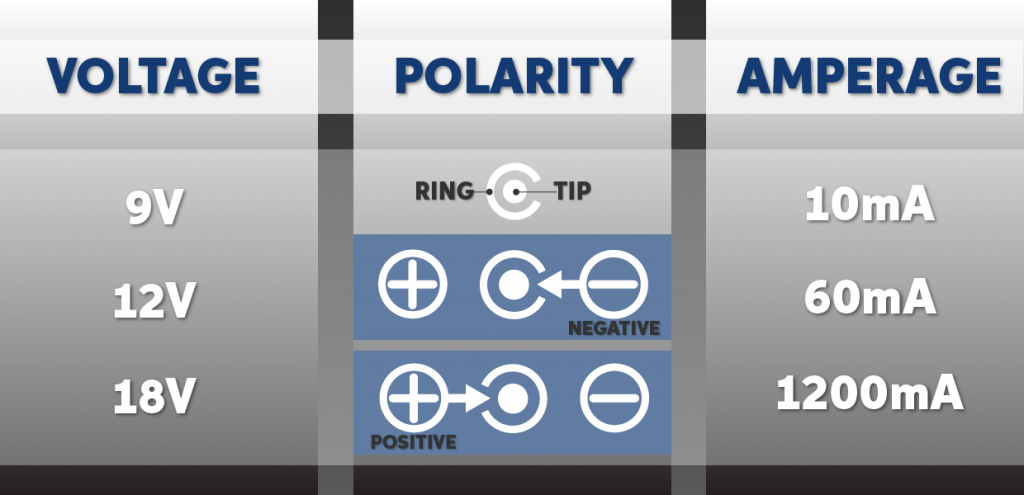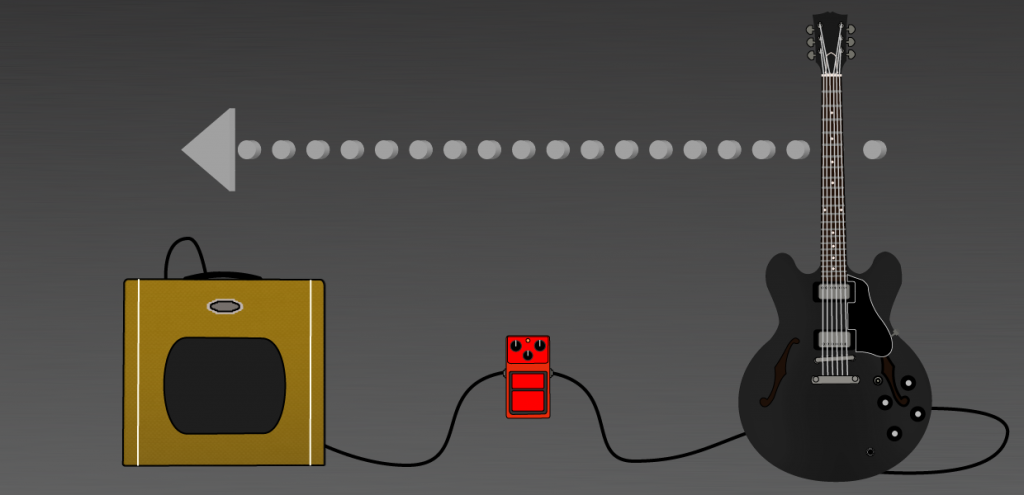what to do when the sound of the bass guitar starts going out when plugged in

In this guide, nosotros will show yous how to troubleshoot guitar pedals. Yous'll acquire well-nigh ability supply compatibility and how to maintain clear signal throughout all your cabling. Follow each of the sections below to get started.
- Effects pedal non working
- Check pedal power supply compatibility
- Secure and exam cablevision connections
- Isolate and test pedal
- Related content
Whether you are troubleshooting no point or a whole bunch of dissonance from your rig, it'southward possible that a pedal may be the problem. Many times, though, it's non a pedal, and the consequence can exist traced to the amplifier, guitar, or power. The only way to actually know is by order of emptying. If your guitar sounds fine when connected direct to the amp merely adding pedals causes issues, then yous've probably got a pedal trouble.
When a pedal does not work correctly, you beginning demand to review its ability supply specifications and cablevision connections. One time the power supply and connections are good to go, go on to isolate and test the pedal.
Render to Top
Almost guitar pedals are powered by a power supply adapter (wall wart or isolated), though some can exist battery powered, too. If you are powering your pedal with a bombardment, the first thing to attempt is a new battery. If y'all are using a power adapter, there are a few parameters that must match, or the pedal won't work correct (and may suffer harm, also!). The most important specification is the current type: Air conditioning or DC. Always use the correct electric current and adapter type/size. Some ability adapters look similar just may not fit quite right, and then simply use a compatible power plug.
Other than electric current blazon, pedal power has three parameters: voltage, polarity, and amperage. When you prepare a guitar pedal, make sure the power supply matches those three requirements. Using an incompatible power supply can damage your pedal, especially if the voltage or polarity don't match.
Once the guitar pedal is connected to a uniform power supply, go ahead and test the pedal.
- Check that the power supply'south and pedal's electric current types match exactly.
- Check that the ability supply's and pedal'south voltage ratings friction match exactly.
- Bank check that the power supply's and pedal'southward polarity indicators match exactly.
- Check that the total amperage draw from the pedal(s) does non exceed the power supply'south amperage rating.
Apply a ability supply that has the verbal voltage listed on your guitar pedal. About pedals take a voltage rating label, but bank check the user manual to verify the guitar pedal's voltage requirement. Some pedals can accept multiple different voltages, but this is not typical. Employ the correct adapter when using multiple 9V outlets to power and 18V pedal.
Check that the guitar pedal and power supply have the exact same polarity (in that location are simply two options). This is indicated past a circumvolve with a ring around it and is identified as center negative or positive. About pedals are center negative (–), only ever double cheque! Practise not utilise the incorrect polarity!
For amperage, the power supply needs to supply plenty current. That means information technology must see or exceed the guitar pedal's amperage requirement (10mA, 100mA, 500mA, 1A etc.). If y'all're non sure nearly the amperage rating, check the pedal's manual or employ an amperage meter. When daisy-chaining pedals, add each amperage rating together and make sure the ability supply meets or exceeds the total.

Return to Top
2. Secure and test cable connections
Once you've verified the guitar pedal is connected to a compatible power supply, the side by side step is to bank check each cable and connection. All yous need to exercise is make sure the cable is secure and passes clear signal. Near of the time you'll be using a standard 1/4-inch unbalanced (TS) guitar cable, but some pedal connections require a balanced (TRS) cable. If yous oasis't done and then all the same, verify yous are using the correct cables and that they are inserted all the fashion into their jacks.
Cable testers are the best manner to make sure a cable works. There are many relatively inexpensive testers out there, and they're quite useful. Another elementary (and free) test is to plug the guitar directly to your amp and listen for whatsoever crackles, static, or dropouts. If your guitar and amp sound normal, and then the cable passes signal and is okay to utilize.
If you're using cables from a pedalboard kit, the best matter y'all tin can practise is measure twice and cut in one case. Exam each finished cable with a cable tester before adding it to your pedalboard. If it's not working right away, trim a little off the cablevision and so apply a twisting motion to reseat information technology back into the plug. Learn more than about Cable Management for Pedalboards.
- Tighten loose jacks and cables fingertight.
- Cheque that each cable is securely connected to the correct input or output jack and examination your signal.
- For custom cut-cables, disconnect the cablevision, reseat the wire into the plug, and firmly tighten the cap. Reconnect and test your signal.
- Exam a questionable cable with a cable tester. If it tests negative, either swap cables, recut and reseat/resolder information technology, or supercede it with a new i.
three. Isolate and exam pedal
Once your ability supply and cables are in working club, the final step is to test the pedal all past itself with no other pedals or effects in your signal chain. If yous are troubleshooting an consequence with more than 1 pedal, examination each one individually, then connect them together and exam over again. This volition help yous diagnose the problem by process of elimination: power, connections, pedal settings, etc.. Brand sure you accept the effect engaged and requite it a test drive. If it sounds like it should, then your pedal passes the test. If it doesn't, dial in a clean tone and then test each knob and switch i at a time.
When troubleshooting a problematic pedal, test it past itself. Once you lot verify the pedal works equally it should, add it back to your pedalboard and test once more with your other pedals.
- Connect your guitar to the input jack of the pedal.
- Connect the output jack of the pedal to your amplifier.
- Turn your guitar all the way upwardly, set the amplifier to a clean setting, so engage your pedal.

Levels and pedal order
While your pedal may exist okay on its own, it may not reply the same when used with other pedals. Pedals with level command peculiarly demand actress consideration when balancing proceeds staging through your signal chain. Be enlightened of what level each pedal, amp, and FX loop connection expects and how it responds.
Some pedals sound improve in certain combinations than others. Every pedalboard is unique, so experiment with the society of your pedals to detect the exact sound y'all're searching for. Loop switchers give you tremendous flexibility and can help resolve issues with guitar pedal order. For more information, cheque out the switchers below or scout our Understanding Pedal Order video.
If you are still experiencing noise, specially when connecting to your amplifier without any pedals, then the effect might be in the preamplifier or ability section of the amp. If you have a tube amp, perhaps ane of the tubes needs to exist replaced. Learn more on our Tube Amp Troubleshooting Guide.

Related content
- Noise, Buzzing & Humming from Tube Amps
- Tube Amp FAQ
- Guitar Care and Maintenance Guide
- How To Gear up Up Your Electrical Guitar Function 1: Adjusting the Truss Rod
Return to Top
When you demand help, Sweetwater has the answers!
Our knowledge base contains over 28,000 expertly written tech manufactures that will give you lot answers and help you lot become the most out of your gear. Our pro musicians and gear experts update content daily to keep you lot informed and on your way. Best of all, it's totally Complimentary, and it's but another reason that you get more at Sweetwater.com.
Source: https://www.sweetwater.com/sweetcare/articles/troubleshooting-guide-for-guitar-pedals/

0 Response to "what to do when the sound of the bass guitar starts going out when plugged in"
Post a Comment